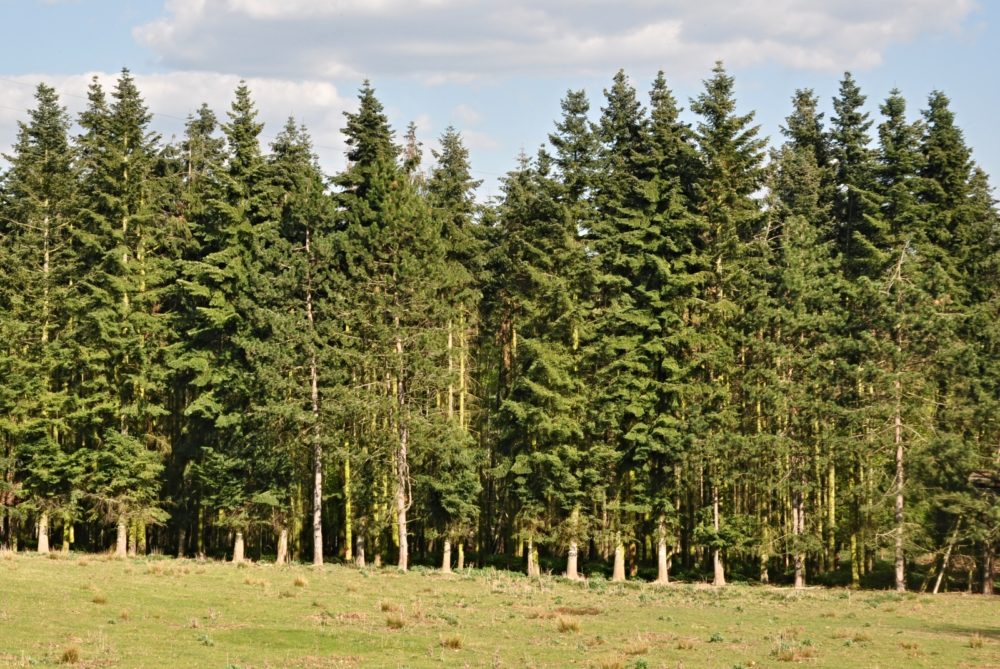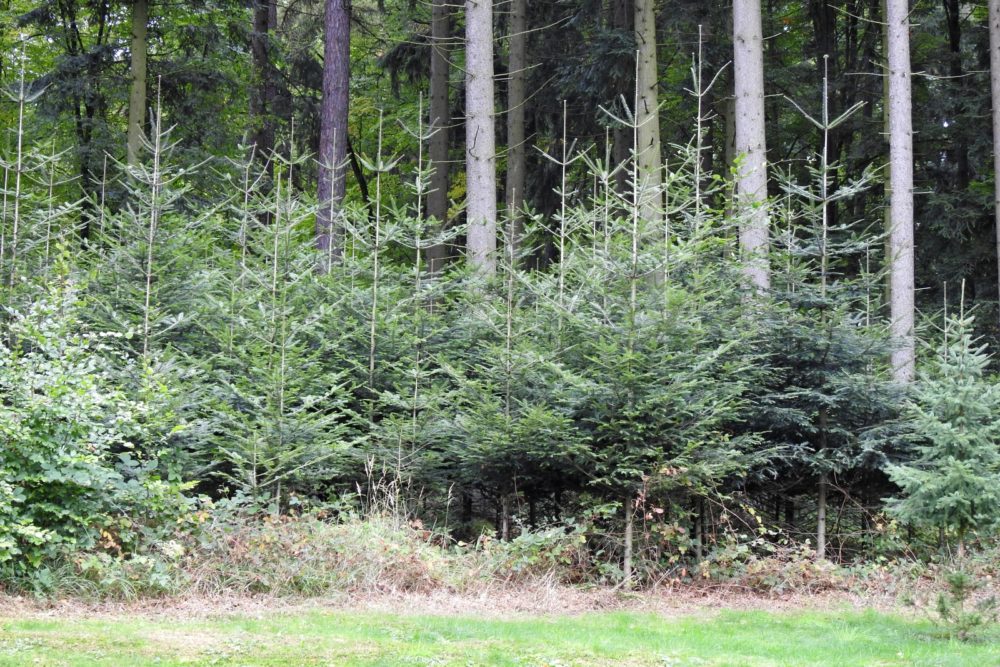Prospects for grand fir in Bohemia
One of the traditional approaches of the European forestry strategy is the introduction of tree species from other regions. Among these introduced tree species, the grand fir is considered one of the most successful after the Douglas fir. However, in certain conditions, it has the potential to become invasive. Currently, the grand fir is grown on a total area of 10,459 hectares in Europe, and 1,508.96 hectares in the Czech Republic. Nevertheless, non-native tree plantations are also affected by climate change, and it is becoming increasingly apparent that the previously recommended regional species and provenance structure need to be re-evaluated.
Research on the origin and genetic variability of forest tree species is a crucial source of information about the relationships between these species and their environment. It provides accurate data on the long-term growth reactions of different sub-populations of woody plants to new environments. This research is irreplaceable for gaining knowledge about the variability of forest tree species.
 Photo: Forest stand with grand fir in the Central Bohemia, author Jan Řezáč
Photo: Forest stand with grand fir in the Central Bohemia, author Jan Řezáč
The International Union of Forestry Research Organizations (IUFRO) conducted a large-scale provenance experiment to gain knowledge about the growth of grand fir in varied environmental conditions. During the experiment, 41 seed samples were collected from British Columbia, Washington, Oregon, Idaho, and Montana between 1974 and 1976. These samples were then distributed to 22 research institutions in 17 countries for further research.
Based on the latest research findings, it is recommended to use the provenances from the low and middle positions of the coastal area that stretches from the northern edge of the Olympic Peninsula to the south of the Puget Trough, and from the eastern slopes of the Washington Cascades. For instance, the Bear Mountain provenance (Louella-Blyn) has shown outstanding growth both in its native range and across Europe.
Provenances from the western slopes of the Cascades, such as Buck Creek in Darrington, have proven to have excellent height growth and lower frost sensitivity in trials conducted in Germany and the Czech Republic. The provenance from east Vancouver, characterized by early germination and good growth, is suitable for low and medium locations in central and (north)western Europe (Ireland, Great Britain, Holland, Germany, the Czech Republic, Poland) and for the warmer regions of south eastern Europe (Northern Macedonia).
Scientists from VÚLHM, v. v. i. have evaluated the growth of grand fir on the provenance trial of Drahenice, located in the Central Bohemia, at the age of 41 years. They compared their findings with published results from other plantings that were of comparable age in the IUFRO 1974–76 series. They also examined the newly enacted rules for the transfer of giant fir reproductive material from the USA and Canada to the Czech Republic. The information acquired over the years was taken into consideration during the evaluation process.
International provenance trial No. 212 – Drahenice was established in 1980 and is currently owned by the noble Lobkowicz family. It is professionally managed by Lesy SLM Drahenice, s. r. o. The trial aims to verify 25 provenances from five climatically homogeneous regions of the USA and Canada. These provenances come from the US states of Washington (WA), Oregon (OR), Idaho (ID), and Montana (MT), as well as from Vancouver Island, which is part of the Canadian province of British Columbia (BC). As of the assessment date, the trial had 831 individual plants under observation.
 Photo: Young stand of grand fir in the forest close to Brno, author Jan Řezáč
Photo: Young stand of grand fir in the forest close to Brno, author Jan Řezáč
Buck Creek (30,0 m), Tulalip (30,0 m), Salmon River (29,9 m), Mount Prevost (29,5 m), Bear Mountain (29,5 m), and Clearwater (29,5 m) provenances showed the greatest height growth.
Provenances Clear Lake (35.5 cm), Beaver Creek (33.3 cm), Sproat Lake (32.4 cm), Bertha Hill (31.5 cm), Clearwater (31.3 cm), Bear Mountain (31.0 cm) and Gardiner (31.0 cm) showed the best DBH characteristics.
Standing volume above 1100 m3/ha was achieved in case of provenances Bear Mountain (1165 m3/ha), Clearwater (1128 m3/ha) and Sproat Lake (1120 m3/ha).
After examining all the parameters, it was found that Oyster Bay had the best rating in terms of production and quality. It was followed by Bear Mountain, WA, Clearwater, ID, Sproat Lake, BC, and Kaye Road, BC. However, these provenances showed some quality deficiencies such as lower vitality, worse stem form, and thicker branches. The Crescent Creek and Clear Lake provenances were rated the lowest for production and quality.
Grand fir wilting is currently observed in various places in the Czech Republic. This is primarily caused by aphids, followed by infestations of weevils and bark beetles. However, the provenance areas of Drahenice, Hrubá Skála, and Habr remain in relatively good condition, allowing for further evaluation. Measurements taken in the Drahenice area confirm the correctness of the set rules for the transfer of reproductive material. In particular, provenances from the coast of Vancouver and Washington show the highest potential.
 Photo: Branch of grand fir, from top (left) and bottom (right), author Jan Řezáč
Photo: Branch of grand fir, from top (left) and bottom (right), author Jan Řezáč
After evaluating the data, it was discovered that the Clearwater provenance from Idaho has excellent growth characteristics. Although this area is not suggested for importing reproduction material for operational use, it is still recommended for experimental purposes. Based on this knowledge, the scientists propose testing the Clearwater provenance, along with other provenances from the North region.
It is expected that ongoing climate changes will result in longer periods of drought in the Czech Republic, which will significantly affect the resistance of grand fir. The habitat conditions of the tree will play a crucial role in its reaction to these changes, and it may demonstrate different adaptations even in locations that are relatively close to each other. Generally, the grand fir prefers wetter soils, but there are instances where it has been found in drier habitats, such as Hrubá Skála locality.
Despite the recent attacks by the weevil and midge weevil, there are still mature forests that have not been affected. These forests regenerate well with sufficient light. One such area is the Drahenice research area, where weed growth is rare and natural regeneration is significant. However, there are doubts about the future growth potential of grand fir tree species. Therefore, it will be necessary to explore new approaches to ensure its growth and survival.
The paper “Evaluation of the IUFRO provenance trial „Drahenice“ (Central Bohemia) with grand fir at the age of 41 years” (Vyhodnocení provenienční plochy IUFRO s jedlí obrovskou na lokalitě Drahenice ve středních Čechách ve věku 41 let was created as part of the NAZV research project No. QK22020045 and can be downloaded here.
Authors: Jiří Tomec, Czech Environmental Inspection, regional inspectorate Prague (Česká inspekce životního prostředí, oblastní inspektorát Praha); Jaroslav Dostál, Martin Fulín, František Beran, Petr Novotný, FGMRI (VÚLHM, v. v. i.), e-mail: pnovotny@vulhm.cz
According to the original, prepared by Ing. Jan Řezáč, FGMRI (VÚLHM, v. v. i.), e-mail: rezac@vulhm.cz
